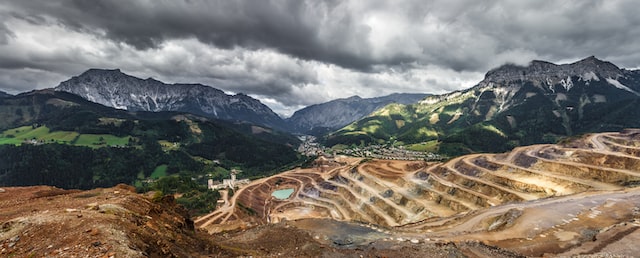Australia’s mentors of mining technology are trying to bring manufacturing home but foreign raiders continue to snap up local talent.
Swedish equipment giant Epiroc, whose $2.5 million electric truck drove onto the floor of a recent mining expo, is acquiring Australian innovation at a rapid pace and supplying it back to the industry.
In the past month, it has bought automation firm Remote Control Technologies, digital geological imaging startup Geoscan and a majority stake in Radlink that provides mines with the wireless networks they need to use high-tech equipment.
Australia is funding research and innovation to export commodities as cheaply as possible, in the largest volumes possible, with the lowest possible emissions, industry mentor Adrian Beer says.
But the future of mining depends on digital solutions in workplaces that, under existing practices, are dangerous and emissions intensive.
Companies can substitute a person with a drone in high-risk environments or use nanosatellites and high-tech mapping rather than dig thousands of holes while prospecting.
“Instead of feeding other countries’ manufacturing sectors, let’s turn that technology into a product or service, which conveniently consumes all those minerals,” Mr Beer tells AAP.
The former coalition government funded six so-called industry growth centres, including one for mining.
Despite putting them under review, federal Industry Minister Ed Husic has no intention of shutting them down.
“The METS (mining, equipment, technology and services) Industry Growth Centre undertakes important work bringing together industry, research organisations and government,” a spokesperson for the minister tells AAP.
“This work not only helps the mining sector but plays a crossover role for technology in other sectors, backing Australian industry and know-how.”
The review of the centres found the hubs helped make the economy more competitive, resilient and sustainable.
But the taxpayer funding was temporary and there was no new support in Labor’s first federal budget last month, despite Mr Husic being a self-declared tech nerd.
Instead, the growth centres have been given permission to spend any leftover funding until mid-2024 while the minister mulls a pitch for next year’s budget.
There’s also an election commitment to add another, the Powering Australia Industry Growth Centre, to support private sector innovation needed to shift the electricity grid from fossil fuels to renewable energy.
But the industry sees a need for government support for commercialising ideas, as other countries do.
And as automation, robotics, artificial intelligence and clean energy technology are useful across an economy, the advances made in mining will benefit manufacturing and other sectors.
The existing growth centre for mining, equipment, technology and services, known as METS Ignited, has worked with 76 partners to turn $15 million in taxpayer funding into a network of companies.
Industry has matched the funding by 2.5 times, and turned the seed funding into combined expected revenue of $900 million and 1000 new jobs.
“What we’ve been doing is funding the company who can take the research and turn it into a product and sell it not only to one industry participant but to all industry participants,” Mr Beer, chief executive of METS Ignited, says.
“That’s how you build the bridge.”
Their project investment criteria are led by people from the resources industry, who have decades of experience in commercialising technology.
“So they have to pass the commercial sniff test,” Mr Beer says.
“You can’t expect government officials to be able to make good investment decisions around technology to address the needs of the sector.”
Recent announcements have seen the national science body CSIRO get more funding to commercialise research.
“Why aren’t we giving them more funds to do more research,” Mr Beer says.
“And why aren’t we funding Australian technology companies to have the responsibility of commercialising?
“Don’t make a growth centre sustainable. Let the growth centres fund businesses that will be sustainable and let the economy sustain itself.”
METS Ignited has set up the Australian Innovation eXchange, which will work across industries.
It intends to unlock and commercialise Australian technology and research that already exists but is often stranded in research centres or within supply chains of one sector or company.
The launch coincides with a shift to think about technology beyond simply IT and software, to include industrial technology and decarbonisation.
Australia’s fledgling robotics industry has been described as immature, fragmented and invisible, and most rival economies are making significant national investments.
But one of the country’s leading thinkers in robotics and artificial intelligence has helped devise a national strategy.
“We know that Australia produces a lot of great talent and technologies in robotics,” says Robotics Australia Group chair Sue Keay, also robotics technology lead at OZ Minerals.
“It is a matter of creating the right conditions to see this industry flourish.”
She wants Australians to benefit from the carefully nurtured talent and technologies.
New tech could help protect the environment, provide services to remote communities, reduce healthcare costs, and tackle the decarbonisation and sustainability challenges.
Bringing manufacturing back to Australia could also provide safer and more fulfilling jobs.
Mr Beer says industrial technology is the backbone of the resources sector, with spillover benefits for the economy.
And yet meetings hosted by the federal government in recent months have been largely industry associations, international companies, manufacturers and primary producers – not local tech companies.
Dr Keay recommends better links to help bridge the commercialisation gap – and a seat at the table with government.
Marion Rae
(Australian Associated Press)






